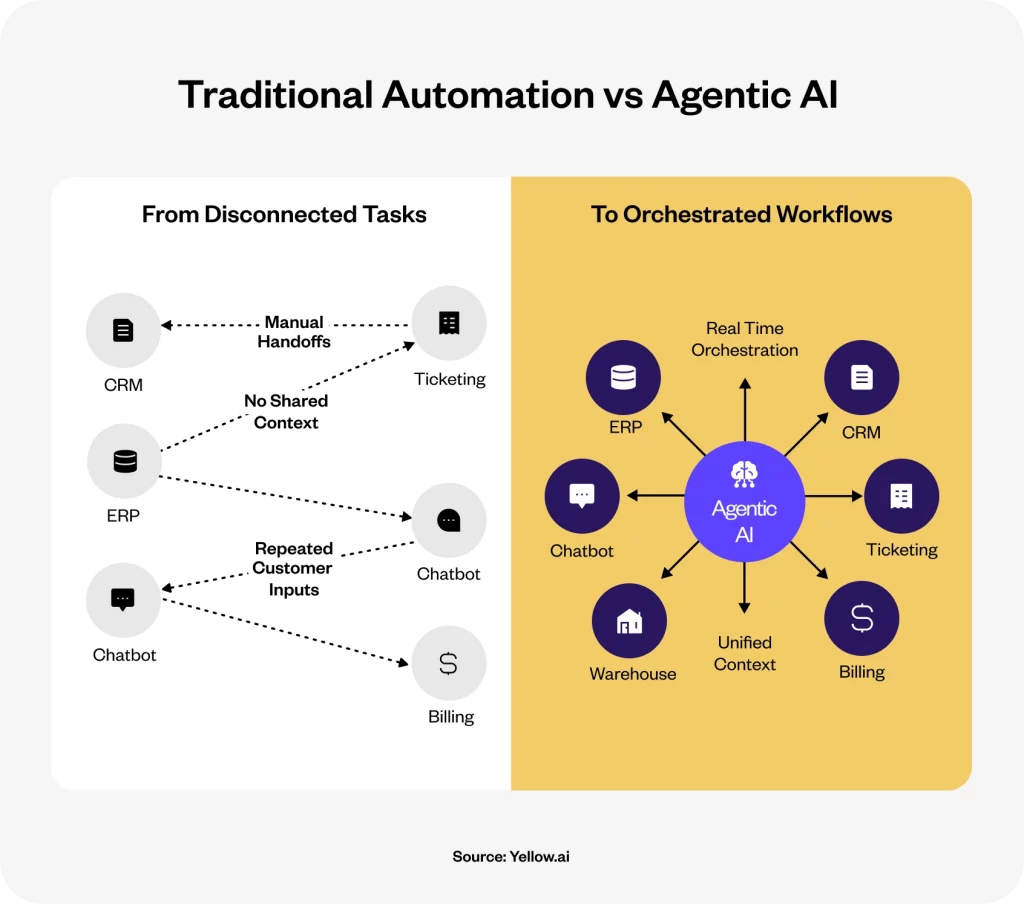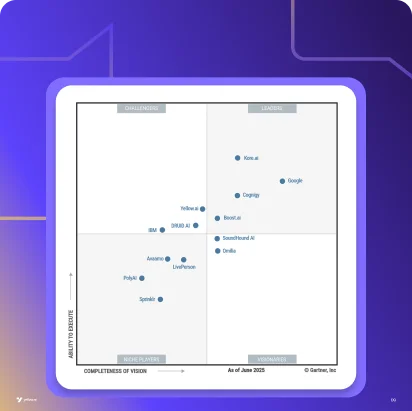According to a recent McKinsey Global Survey, 78% of organizations now use AI in at least one business function, but only a small fraction view themselves as fully mature in its deployment, meaning integrated into everyday workflows and delivering measurable outcomes.
That gap between experimentation and execution is exactly where Agentic AI becomes relevant.
Automation isn’t the issue. The challenge enterprises face today is how tools operate independently and fail to work together, resulting in disconnected workflows and poor outcomes. Agentic AI fixes this by moving from isolated task execution to coordinated orchestration, making automation meaningful at scale.
What Is Enterprise Automation?
Enterprise automation uses technology to handle repetitive tasks and workflows across departments, like HR onboarding, finance approvals, IT ticketing, and customer support automation. It’s designed to save time, reduce errors, and help teams focus on more critical work.
The problem, however? Most automation is often rigid and isolated. Finance tools don’t talk to CRM systems. HR workflows break when exceptions occur. Instead of end-to-end flow, you get disconnected fixes patched together by manual effort.
Customer support is no different. Bots can reset passwords or answer FAQs, but the moment a request spans multiple systems, like refunds, order updates, or escalations, they break. Agents are left to stitch together context across chats, emails, and tickets, slowing resolution and frustrating customers.
To truly work, automation today must coordinate tasks across teams, systems, and channels, not just complete one isolated step. Enterprises now require workflows that can adapt in real time, pull context from multiple sources, and deliver seamless outcomes, from support tickets to finance approvals to order fulfillment. This shift isn’t driven by hype, it’s fuelled by rising customer expectations and advanced enterprise tech.
According to Salesforce, 84% of customers say the experience they get matters just as much as the product or service itself. That’s why fragmented automation, where tools don’t share context, simply fails. Agentic AI addresses this by transforming task automation into full orchestration, ensuring every step makes the journey smoother, faster, and more consistent.
Enterprise Automation Is Everywhere, So Why Are Workflows Still Broken?
Most enterprises already use automation in some form. IT automates password resets. HR streamlines onboarding checklists. Customer support uses chatbots to handle basic queries. On paper, it looks like progress.
But in practice, things still slip through the cracks.
Customers raise a complaint through chat, only to be told to email support. A refund request gets stuck because the chatbot can’t access billing data. Internal teams escalate routine issues because no system sees the full picture.
These failures happen because most automation is task-specific and disconnected. One tool handles a single step. Another manages a separate channel. They don’t share context. They don’t adapt when something changes.
Problem: A customer asks for a refund on WhatsApp. The bot logs a ticket but can’t check the order status. A human agent calls back three days later, asking the customer to repeat everything. The refund is delayed. The experience is broken.
Solution: With Agentic AI, the same request could trigger a cross-system flow. The AI agent checks the order in the CRM, verifies refund eligibility, updates the ticketing system, and notifies the customer, all without escalation. This isn’t just automation. It’s AI orchestration that sees the bigger picture and acts on it.
Until automation moves beyond isolated tasks and starts handling full workflows, these gaps will persist. Agentic AI offers the missing coordination layer, bringing context, continuity, and outcomes to enterprise automation.
Understanding Agentic AI
Most automation today is reactive. It waits for inputs and follows pre-set instructions. If something unexpected happens, the process stops, or worse, fails silently.
Agentic AI is built to do more than just automate a task.
It can follow through on a goal, from understanding what’s needed to taking the right steps to get it done. It works across systems, keeps track of context, and moves the process forward without needing constant human direction. In simple terms: it doesn’t just answer a question or trigger a workflow. It sees the bigger picture and handles the steps that come next.
These systems can observe what’s going on, make decisions based on context, and take action, without needing human intervention at every step.
Where traditional automation might log a ticket when a customer says “I need help,” Agentic AI goes further. It identifies the issue, checks past interactions, accesses relevant systems, and takes the next best step, like resolving the problem directly or escalating with full context.
The key difference here is that it doesn’t just execute tasks. It coordinates outcomes across tools, channels, and teams. And it keeps improving as it learns from every interaction.
This makes Agentic AI especially useful in environments where complexity, variability, and volume are high, like customer service, internal support, or order management.
Related reads:

Why Traditional Automation Tools Can’t Keep Up In 2025
Automation has helped enterprises cut costs and scale basic operations. But once you move beyond isolated tasks, many tools show their limits. Most traditional automation works when inputs are predictable and workflows are linear, but real-world enterprise processes rarely follow a script.
In customer service, for instance, when queries move across chat, email, and ticketing systems, automation often breaks down. Without context sharing, customers repeat themselves and agents work blind.
79% of customers expect consistent experiences across departments, yet 55% say it feels like they’re dealing with separate companies. That gap shows why automation must evolve, from rigid task execution to intelligent orchestration that adapts in real time.
Here’s where automation often falls short:
1. Rigid rules don’t handle real-world complexity
Legacy bots and scripts follow predefined paths. If everything goes as expected, they work. But the moment an exception arises, a missing form, an edge case, a customer using unexpected language, they stall or pass the issue to a human.
For example: Imagine an employee reaches out to the internal service desk saying, “I can’t access the dashboard after my role change.” A traditional automation might simply tag it as a login issue and trigger a password reset. But the real problem could be outdated role permissions or a missing system update. Without understanding intent, the automation sends the user in circles, escalating a simple fix into a time-consuming ticket.
2. Systems operate in silos
CRM, ticketing, logistics, and billing tools are often automated independently. But they rarely communicate in real time. This means one system might complete a task without knowing what happened in another.
That disconnect shows up fast. A chatbot logs a ticket, but the warehouse system still shows the item as shipped. The human agent who steps in later sees only half the story, and the customer ends up waiting.
3. No shared context across channels
Most automation doesn’t retain memory. Each time a customer reaches out, via chat, email, or voice, it’s treated as a new interaction. Prior conversations, escalations, or actions aren’t carried forward.
This lack of context leads to repetition, frustration, and dropped experiences. A customer explains their issue in chat, gets transferred to voice, and is asked to repeat everything again. Automations promise consistency, but without context, it tends to deliver fragmentation.
How Agentic AI Enables End-to-End Enterprise Automation
For most enterprises, AI automation lives in fragments. One tool handles HR requests. Another manages ticketing. A third responds to customer chats. But these systems rarely share information or work together, resulting in broken workflows, redundant handoffs, and delays that frustrate both customers and employees.
Agentic AI changes this by acting as the connective layer that brings intelligence, coordination, and adaptability to every step of the workflow. It doesn’t replace existing systems, it activates them through three core capabilities:
1. Understands intent and context across touchpoints
Agentic AI begins by understanding what the user is trying to accomplish, not just parsing keywords, but interpreting intent based on historical data, user behavior, and system inputs.
Whether the interaction starts on WhatsApp, continues on email, or escalates through a ticketing system, the AI agent preserves context throughout. It pulls relevant data from the CRM, checks previous interactions, and avoids asking the user to repeat information.
Example: A customer checking on a delayed refund doesn’t need to explain their issue twice. The agent recognizes the original request, confirms the refund status via backend systems, and follows up proactively, without escalating.
This kind of contextual understanding is essential for enterprise-grade automation where workflows span multiple tools and user touchpoints.
2. Orchestrates actions across multiple systems and teams
Traditional automation tools focus on completing isolated steps within a specific platform. Agentic AI orchestrates multiple steps across platforms, sequencing them in the right order, with the right logic, to deliver outcomes.
It connects with tools like Salesforce, SAP, ServiceNow, or proprietary internal systems, not just to pull data, but to trigger and complete processes.
This coordination eliminates gaps that typically emerge when departments rely on siloed automations that don’t share visibility.
3. Learns and improves with every interaction
Enterprise workflows don’t stay static. New scenarios emerge, exceptions become common, and business rules evolve. Agentic AI is designed to learn continuously, detecting bottlenecks, surfacing common failure points, and recommending updates to flows and knowledge articles.
It doesn’t just execute. It reflects, analyzes, and improves, based on real usage patterns and user feedback.
Example: If a high volume of customer queries repeatedly hits the same dead end, the agent flags this and suggests an automation path or content fix, turning passive failure into active improvement.
This feedback loop is what distinguishes intelligent automation from static rule engines. It enables organizations to scale automation sustainably, without needing to rebuild flows every time a variable changes.
Together, these capabilities shift automation from a departmental toolset to a true enterprise operating layer. Instead of siloed bots or hardcoded scripts, Agentic AI introduces a system that understands context, acts with purpose, and improves as your operations evolve.
Additional reads:
Enterprise AI Use Cases: How Agentic AI Solves Real Operational Challenges
Below are five industries where Agentic AI is transforming operational efficiency and enterprise automation at scale.
1. Banking & Financial Services
Loan processing, compliance checks, and KYC flows often require coordination across systems and manual inputs. Agentic AI connects these steps into a unified flow.
Example: A bank uses Agentic AI to scan KYC documents, verify background data, and auto-approve low-risk loan applications, without switching between systems.
2. Retail & eCommerce
Managing returns and post-purchase issues can be time-consuming when systems aren’t integrated. Agentic AI handles the entire resolution process in one flow.
Example: A retail brand uses it to verify return eligibility, update inventory, and trigger payment reversals automatically, reducing support load and customer effort.
3. Healthcare
Routine patient workflows, insurance checks, consent forms, appointment assignments, often rely on fragmented tools.
Example: A hospital system uses Agentic AI to handle pre-visit admin: verifying insurance, gathering documentation, and routing patients to the right care team.
4. Telecom
Telecom onboarding spans ID checks, plan selection, and provisioning, often across multiple systems and channels.
Example: A provider uses Agentic AI on WhatsApp to activate SIMs end-to-end: collecting documents, verifying IDs, and enabling service in real time.
5. Utilities
High volumes of outage reports and billing queries can overwhelm call centers during service disruptions.
Example: An energy provider uses Agentic AI to log outage locations, trigger dispatches, and send live updates via chat and SMS, keeping customers informed without agent intervention
How to Get Started with Agentic AI in Your Enterprise
If you’re just beginning your Agentic AI journey, the goal isn’t to overhaul your systems. It’s to make your existing tools work smarter, together.
Here’s how to get started:
1. Don’t replace your current systems. Connect them.
You already have tools like CRMs, ticketing platforms, HR systems, or ERPs in place. Agentic AI doesn’t ask you to throw them out. Instead, it integrates with what you use today and makes those tools work better together.
By layering on top of your existing setup, it can help you automate tasks across platforms, without switching between screens or teams.
2. Start with one broken journey
Look at common pain points, places where automation exists but still requires manual effort. These might include:
- New employee onboarding
- Customer refund requests
- Internal IT support tickets
If people are constantly following up, switching channels, or repeating information, that’s a sign the process is disconnected. Agentic AI is designed to fix exactly that.
3. Choose a platform designed for orchestration, not just answers
Many AI tools can answer questions. But few can get work done.
Agentic AI doesn’t just talk, it acts. It understands what the user needs, accesses the right systems, and completes the task end-to-end.
As Yellow.ai’s SVP of Product Vikas Bhambri said in a recent Envision Voices episode:
“You can either give a person a better answer, or you can actually solve their problem. That’s what Agentic AI is here to do.”
That’s the difference between traditional bots and AI agents.
4. Scale once you see results
Once you’ve successfully automated one high-impact journey, use it as a model. Expand to other teams or workflows, from operations and logistics to customer experience and employee support.
Agentic AI grows with your business, not ahead of it.
Embed the youtube video Envision voices ep 5 here –
How Yellow.ai Supports Agentic AI at Scale
For most enterprises, the challenge isn’t starting automation, it’s making it scale across teams, systems, and channels without losing consistency or context. Yellow.ai helps solve this by enabling a coordinated, adaptive layer of automation that works across the business, not just within departments.
Context-aware decision-making
Yellow.ai’s agents don’t operate in silos. They access conversation history, CRM data, and business rules to make informed decisions, so interactions feel connected, even when they span multiple channels or teams.
This reduces unnecessary escalations and repeated steps, especially in support and operations.
System-wide AI orchestration
Rather than relying on rigid integrations, Yellow.ai agents coordinate tasks across platforms. They can update a support ticket, trigger a backend action, or notify a user, all in the same flow.
This turns fragmented processes into consistent, trackable outcomes.
Continuous improvement through data
Built-in analytics help teams identify where workflows are breaking down and what needs to change. Yellow.ai makes it easier to refine automations over time without starting from scratch.
1300+ enterprises across sectors like BFSI, retail, and telecom are using Yellow.ai to extend automation across high-impact workflows, without needing to rebuild what already works.
The Only Platform Which is ‘Agentic’
At All Stages of Your AI Agents’ Lifecycle


Conclusion: Why Agentic AI Is the Missing Link in Enterprise Automation
Most enterprises have already invested in automation, across IT, customer service, HR, finance, and more. But ask any team operating at scale, and you’ll hear the same issues:
Workflows break across departments. Systems don’t talk to each other. Customers fall through the cracks. And internal teams spend too much time coordinating tasks that should be automatic.
This isn’t a technology gap. It’s an orchestration gap.
That’s where Agentic AI comes in, not to replace your existing tools, but to make them work together intelligently. It understands the full context behind a request, coordinates actions across platforms, and continuously adapts based on outcomes.
It’s not just about answering faster or triggering a script. It’s about building systems that:
- Understand what needs to happen
- Decide how to get it done
- And drive the outcome, end to end
Agentic AI shifts automation from isolated execution to intelligent, enterprise-wide coordination.
If you’re looking to scale automation without scaling complexity, this is your next step.
FAQs: Common Questions Around Generative vs Agentic AI
What is end-to-end enterprise automation?
End-to-end enterprise automation refers to automating entire workflows across departments, systems, and customer touchpoints, from start to resolution, without manual handoffs. It goes beyond task automation to include coordination, context, and decision-making across the business.
How is Agentic AI different from traditional automation tools?
Agentic AI is built to understand intent, act autonomously, and improve over time. Unlike rule-based automation or static bots, Agentic AI can orchestrate actions across tools and channels, adapt to exceptions, and continuously learn from outcomes.
What is AI orchestration in an enterprise context?
AI orchestration is the ability of AI systems to coordinate multiple tasks, systems, and data flows in real time. In an enterprise setting, this could mean resolving a customer issue by syncing CRM data, updating ticketing platforms, and notifying users, without any human intervention.
Can Agentic AI work with existing enterprise systems?
Yes. Agentic AI platforms like Yellow.ai are designed to integrate with CRMs, helpdesks, ERPs, and internal databases. This allows enterprises to automate intelligently without overhauling existing infrastructure
What are some common use cases for Agentic AI in automation?
Popular use cases include:
- Customer support automation (resolving queries across chat, voice, email)
- Internal service desk (IT, HR, finance support)
- Order management and logistics updates
- Claims processing and form validation
- Agent assistance and back-end task automatiou
How does Agentic AI improve over time?
Through continuous learning. Agentic AI systems analyze past interactions, identify patterns, flag gaps, and suggest optimizations, like creating new knowledge base articles or refining workflows.
Is Agentic AI the same as Generative AI?
No. While Generative AI focuses on content creation (e.g., generating text or images), Agentic AI is designed to take purposeful action. It connects understanding with execution, making decisions, performing tasks, and driving outcomes across enterprise systems.you
























